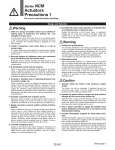
ncm 78 / 85
10秒後にBOOKのページに移動します
Back page 3 1. There is a danger of sudden action by air cylinders if sliding parts of machinery are twisted, etc., and changes in forces occur. In such cases, human injury may occur; e.g., by catching hands or feet in the machinery, or damage to the machinery itself may occur. Therefore, the machine should be designed to avoid such dangers. 2. Install a protective cover when there is a risk of human injury If a driven object and moving parts of a cylinder pose a danger of human injury, design the structure to avoid contact with the human body. 3. Securely tighten all stationary parts and connected parts so that they will not become loose. Especially when a cylinder operates with high frequency or is installed where there is a lot of vibration, ensure that all parts remain secure. 4. A deceleration circuit may be required. When a driven object is operated at high speed or the load is heavy, a cylinder’s cushion will not be sufficient to absorb the impact. Install a deceleration circuit to reduce the speed before cushioning to relieve the impact. In this case, the rigidity of the machinery should also be examined. 5. Consider a possible drop in operating pressure due to a power outage, etc. When a cylinder is used in a clamping mechanism, there is a danger of work pieces dropping if there is a decrease in clamping force due to a drop in circuit pressure caused by a power outage, etc. Therefore, safety equipment should be installed to prevent damage to machinery and/or human injury. Suspension mechanisms and lifting devices also require consideration for drop prevention. 6. Consider a possible loss of power source. Measures should be taken to protect against human injury and equipment damage in the event that there is a loss of power to equipment controlled by air pressure, electricity or hydraulics, etc. 7. Design circuitry to prevent sudden lurching of driven objects. When a cylinder is driven by an exhaust center type directional control valve or when starting up after residual pressure is exhausted from the circuit, etc., the piston and its driven object will lurch at high speed if pressure is applied to one side of the cylinder because of the absence of air pressure inside the cylinder. Therefore, select equipment and design circuits to prevent sudden lurching, because there is a danger of human injury and/or damage to equipment when this occurs. 8. Consider emergency stops. Design so that human injury and/or damage to machinery and equipment will not be caused when machinery is stopped by a safety device under abnormal conditions, such as a power outage or a manual emergency stop. Warning Series NCM Actuators Precautions 1 Be sure to read this before handling. Design and Selection Warning Caution 9. Consider the action when operation is restarted after an emergency stop or abnormal stop. Design the machinery so that human injury or equipment damage will not occur upon restart of operation. When the cylinder has to be reset at the starting position, install safe manual control equipment. 1. Confirm the specifications. The products advertised in this catalog are designed according to use in industrial compressed air systems. If the products are used in conditions where pressure, temperature, etc., are out of specification, damage and/or malfunction may be caused. Do not use in these conditions. (Refer to the specifications.) Consult SMC if you use a fluid other than compressed air. 2. Intermediate stops When intermediate stopping of a cylinder piston is performed with a 3 position closed center type directional control valve, it is difficult to achieve stopping positions as accurate and precise as with hydraulic pressure due to the compressibility of air. Furthermore, since valves and cylinders, etc., are not guaranteed for zero air leakage, it may not be possible to hold a stopped position for an extended period of time. Contact SMC in case it is necessary to hold a stopped position for an extended period. 1. Operate within the limits of the maximum usable stroke. The piston rod will be damaged if operated beyond the maximum stroke. Refer to the air cylinder model selection procedure for the maximum useable stroke. 2. Operate the piston within a range such that collision damage will not occur at the stroke end. Operate within a range such that damage will not occur when the piston having inertial force stops by striking the cover at the stroke end. Refer to the cylinder model selection procedure for the range within which damage will not occur. 3. Use a speed controller to adjust the cylinder drive speed, gradually increasing from a low speed to the desired speed setting. 4. Provide intermediate supports for long stroke cylinders. Provide intermediate supports for cylinders with long strokes to prevent rod damage due to sagging of the rod, deflection of the tube, vibration and external loads, etc. It is assumed the persons determining the stroke requirements have technical training and expertise in the design limitations of pneumatic equiptment and are aware that death, personal injury, and property damage may result from the improper use of these products. Proper use is the users responsibilty.